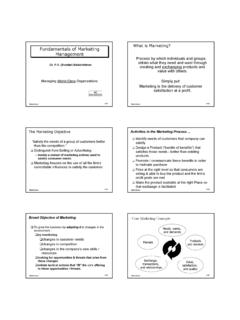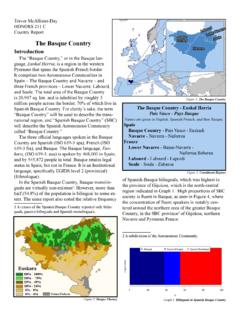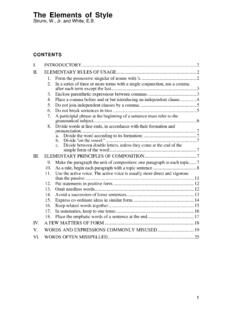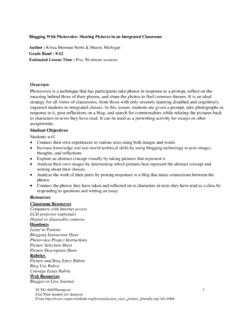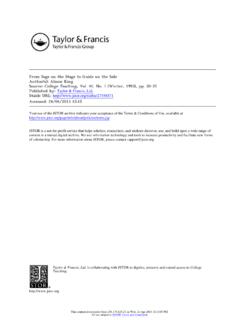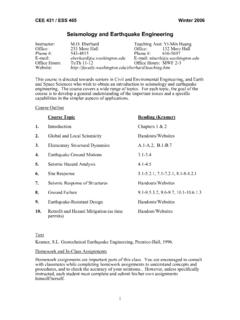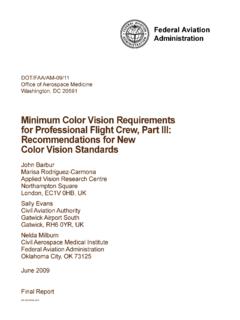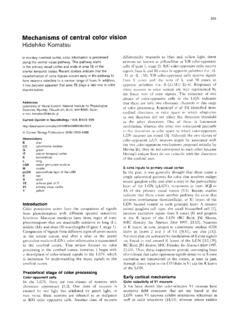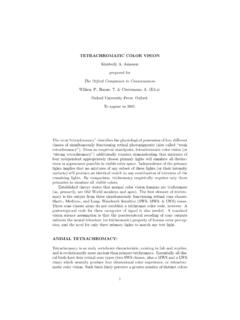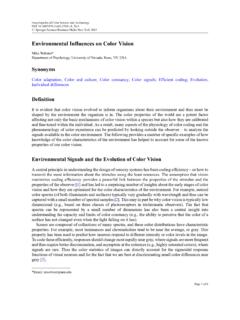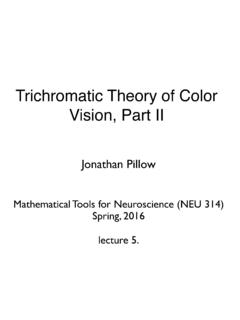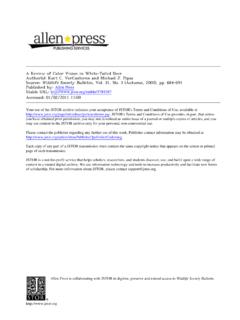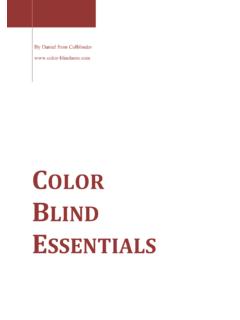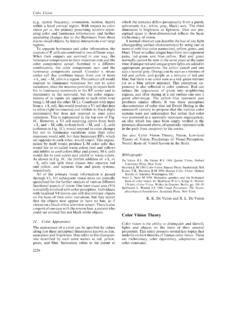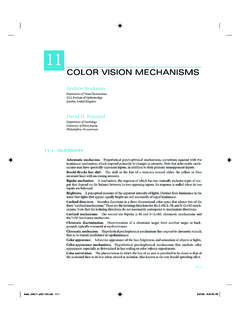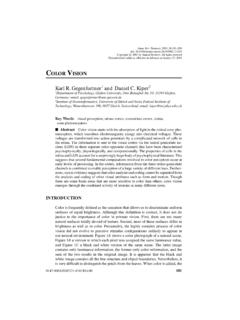Transcription of Our Sense of Sight: Part 3. Color Vision
1 1 Our Sense of Sight: Part 3. Color VisionFeaturing a Class Experiment and Try Your Own Experiment WHAT STUDENTS WILL DO PREDICT and then DETERMINE the colors of some afterimages DISCUSS the opponent Color and channels theories LIST the advantages of Color Vision over black and white Vision LEARN how to design experiments that include specific questions, control conditions, andchanging one variable at a time, for example: TEST their abilities to distinguish shades of colors TEST their skills at picking out detail with and without Color Vision INVESTIGATE the subjective nature of Color namesSUGGESTED TIMES for these activities: 45 minutes for introducing and discussing theactivity, 45 minutes for the "Class Experiment; and 45 minutes for "Try Your OwnExperiment.
2 "SETTING UP THE LABS uppliesFor the Introduction to the Lab ActivitiesOne or more of the following:Disposable camera with flashSeveral large brightly colored items some garish, some pleasant ( , clothing, householditems)Neuroscience for Guide2 Large (8 X 10 or 11 X14 inch) Color print and a black and white copy of this print(this can be a print by a well-known artist, a contemporary poster, a picture from a magazine,etc.)(See Introductory Activities below for how to use these items.)For the Class ExperimentFor each group of four (or other number) students: Black adhesive dot, about 2 cm in diameter Bright red adhesive dot, about 2 cm in diameter Other colors of adhesive dots as available, 4 to 6 colors if possible Several white unlined index cards, each 5 x 7 inches TimerFor Try Your Own Experiment Several series of paint chips from a paint supply store.
3 Try to get at least two identical sets (You may need to ask for out-of-date chips in order that you need not return them) Eight to ten small beakers, clear plastic cups, or flasks, about 200 milliliter volume (more if more than one group wants to do this test) Water Food coloring Magazines with colorful pictures Collection of pieces of colored paper, with several shades of each Color Where s Waldo? Book Large box of crayons (64 or more)Other Preparations For the Class Experiment and Try Your Own Experiment, students can write results on aplain sheet of paper. Construct a chart on the board where data can be entered for class discussion.
4 Decide the size of the student groups; four is a convenient number. Students can decidehow to set up the Color -dot cards and how to record data; one data recorder can summarizethe group results and write them in the class chart. Decide the number of colors to test for the Class Experiment For Try Your Own Experiment, prepare materials in the Supply list and put them out on an Explore table after the Class Modify activities for exceptional students: Students who are red-green colorblind can do the afterimage tests for black-white andblue-yellow Color pairs. Make sure a student who has low Vision is seated in a well-lighted area.
5 If possible,increase the size of the colored dots and white cards for this student. Because concepts of Color have no meaning for people who have been blind frombirth, have these students participate in getting ready for another experiment for thisunit. Such experiments could include teaching the class a few words in Braille orhelping prepare a three dimensional model of visual pathways. Students who arecomfortable talking about their blindness might discuss how they find their wayaround while walking, or how they choose clothing when they cannot see may not want to share this ACTIVITIESGive students initial informationIntroduce Color Vision to the class according to your teaching practices; , with reading,lecture, and discussion before lab work (the Teacher Resource accompanying this unitdiscusses the Visual System in general, as well as Color Vision .)
6 In addition to covering theanatomy and physiology of the system, for the Color Vision experiments you will want to discussthe concepts of opponent colors, Color channels and afterimages. Other topics that may intereststudents include: the way people react to particular colors, animal Color Vision , colorblindness,and other topics you think might come up in the Try Your Own Experiment Color Vision experiments with a demonstrationWhen students enter the classroom on lab day, introduce the activities with an eye-catching short activity: Take pictures with a disposable flash camera to produce a negative afterimage of the whiteflash in students eyes.
7 In this way you can discuss the dark afterimage students temporarilysee after the bright white flash. Place several large, brightly colored items at the front of the classroom (for example, items ofclothing). This introduction leads into a discussion of the subjective nature of Color namingand preferences. Pass around a black and white copy (from a high quality copy machine) of an attractive colorprint of a famous painting, contemporary scene, or good quality picture from a magazine, anddirectly after it, pass the original print. Use 8 x 10 or 11 x 14 inch sizes if possible. The twoimages demonstrate how Color changes our awareness of the presence or our interpretation ofthe importance of objects in a you use only one of these activities, use the others in the Try Your Own Explore Time to engage studentsAfter the introduction, let students explore a table holding the materials for the ClassExperiment.
8 Give them five to ten minutes to see what they will be working with, and when theysit down, ask what they could find out about Color Vision with these I believe my eyes?CLASS EXPERIMENTThe sections below match those in the Student Guide. The comments guideteachers in preparing and teaching the QUESTIONIf you did not use the flash camera afterimage for your Introductory Activity, remind studentsabout afterimages (which you have previously discussed in lecture). Briefly review yourdiscussion of opponent colors, and help students to write the following Lab Question or one thatmatches it closely:PLANS AND PREDICTIONSE ncourage students to add their own knowledge and experiences in order to make predictionsafter you have provided background information.
9 Ask about how long it takes for the negativeafterimage of a flash bulb to go away. Have any of the students seen a Color afterimage afterlooking at one Color for a time?PROCEDURE1. Introduce safety precautions: Follow all standard lab safety guidelines for preparing andteaching the activity; , take precautions to avoid germ spread; wash hands; dispose ofchemicals properly; use equipment Establish the number of students in each group. Decide how many students should beSubjects, and how many should be Data Recorders. All students can do the test and recordtheir own data if Decide how many Color circles each group should Explain the steps in the Class Experiment.
10 These are listed in the Student Guide, Remind students to clean up the lab when they staring at a colored circle on a white background, what will anobserver see when looking immediately at a plain white background?6 DATA AND OBSERVATIONSSee that students are recording observations on a student from each group list their results in a prepared chart on the students to calculate, for all Subjects tested, the average time that the afterimage persistedafter they initially stared at the red dot for one minute, and the average time after staring at it fortwo : THINK ABOUT IT!The following questions can encourage thinking about the activity; add your ownquestions.

